Since moving to Tromsø I’ve been posting lots of northern lights photos, so I guess it makes sense that one of the most common questions I get asked is how to photograph the northern lights. And while snapping a great photo of the northern lights isn’t quite as simple as pointing your iPhone up at the sky and clicking, it’s also surprisingly easy to get great northern lights photos if you follow a few simple tips.
I take northern lights photos both with my iPhone and my professional camera, depending on which I have on hand. Here I’ll explain how to use each to take aurora photos, and I’ll also share some of my exact camera settings for northern lights so you have a place to start.
I’ve also shared more northern lights tips here, as well as the best northern lights hotels in Norway here and the best places to see the northern lights here. And if you want more help check out my northern lights ebook which covers everything you’ll need to know for your northern lights trip.
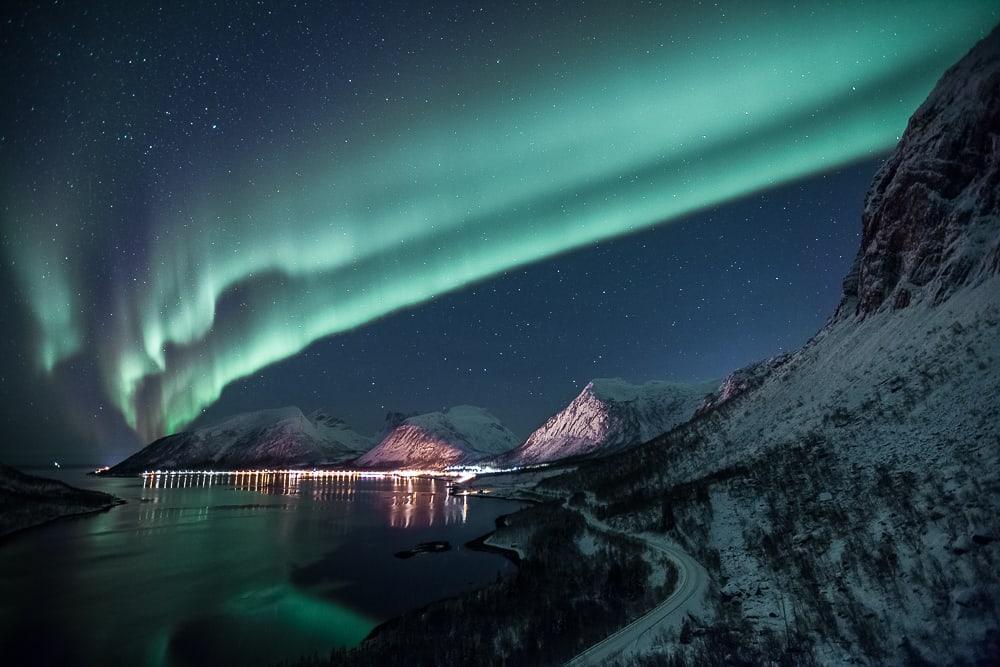
Northern lights photo setting: ISO 1600, f/2.8, 10 second exposure
How to photograph northern lights with an iPhone
I usually see the northern lights here in Tromsø several nights a week while walking my dog (I have a border collie, so we spend a lot of time outside!). And sometimes the displays are so brilliant I have to document them, even if the only camera I have on me is my iPhone.
Now, if you want the absolute best northern lights photos, I don’t advise only using your iPhone. If you have an actual camera, use it. But if the only camera you have is the one on your phone, you can actually get pretty impressive photos of the northern lights with your phone! One thing will be a huge help: a phone tripod.
A tripod helps to take crisp northern lights photos because you’ll need a long exposure time to take photos in the dark, and if you move your camera at all during the exposure your photos will come out blurry.
Newer iPhones (starting with iPhone 11) also have night mode, which will help you to get night photos without a tripod, especially if the northern lights are very bright. These photos won’t be quite as good as photos you take with a tripod, but they’re not bad!
I took these photos with night mode on my iPhone 11 pro without a tripod in the Tromsø city center, during a really bright lights show:
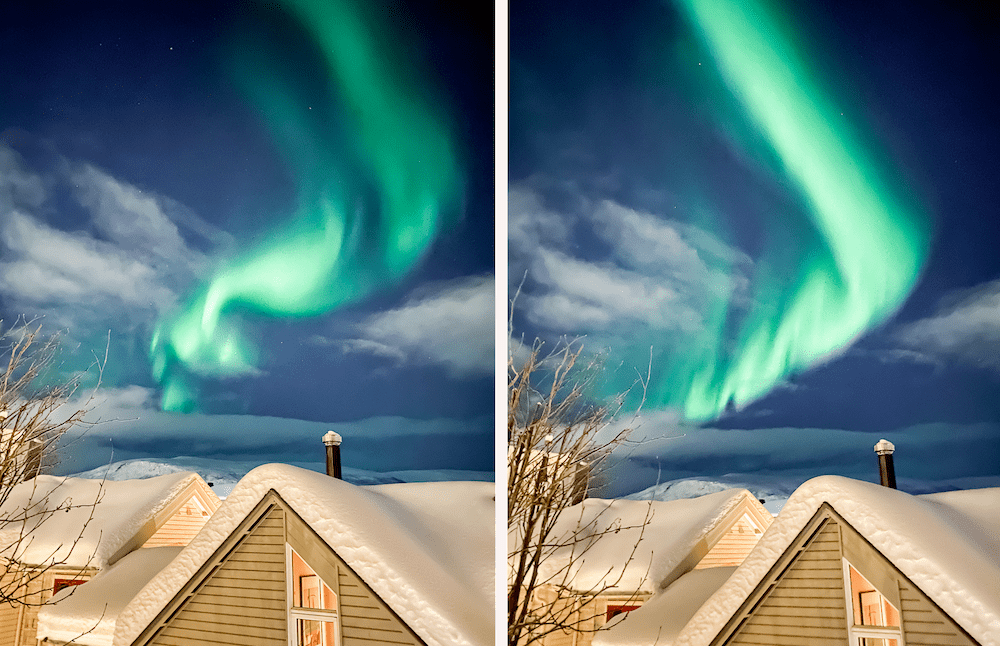
Follow these five steps to use night mode on your iPhone to capture the northern lights:
- Mount your iPhone on a tripod (if you have one). You might want to set your tripod low on the ground and point up at the sky, or you could include some snow covered trees or mountains in the foreground. Don’t worry too much about the framing though, as often the northern lights travel quickly across the sky and you’ll want to adjust your camera placement many times to capture them.
- Do NOT zoom in or out on your camera. Keep the camera at the default 1x mode.
- Activate night mode by clicking the moon icon in the top left corner. Usually it will automatically turn on when your phone detects darkness. The flash should be turned off.
- If you want to focus on something in the foreground, tap it so the camera focuses on it. Otherwise tap the sky so that your camera focuses on infinity (as far away as possible) so the stars will be sharp and in focus.
- Take a test shot. If you’re not using a tripod, try to hold your iPhone as still as possible while taking the shot! It helps to lean your arms against something stable. If the photo is too dark, you can extend the shutter speed by clicking on the yellow half moon above the white shutter button (the button you click to take a photo). Drag the shutter time to the left for longer exposure times (eg. from 5s to 10s). Experiment a little to see what looks best! If the northern lights are very active and moving quickly, you’ll want a shorter shutter time, and if they are weak and not moving much, you can use a longer shutter time to make the lights appear brighter.
If your phone doesn’t have night mode, see if your phone’s camera has a pro mode (or download a pro camera app) where you can adjust all the settings manually. Then you can roughly adjust according to my guide below for taking northern lights with your camera.
How to photograph northern lights with a camera & my exact northern lights photo settings
If you want to buy the best camera for photographing the northern lights, it’s definitely the Sony A 7s III. This is the only camera with good enough low light capabilities to even film the northern lights! I bought it last year and it totally changed my photography.
And this is my favorite tripod, because it’s incredibly compact, stable, and sets up quickly (you want a quick and easy setup when the northern lights suddenly appear). I have the more expensive carbon version because it’s lighter, but if you don’t mind a bit of extra weight the aluminium is also fantastic, and cheaper. You will want to invest a bit in a good tripod, because if the tripod isn’t stable, your camera will move slightly, resulting in blurry photos.
Regardless of what camera you have, you’ll want to use manual mode, and if available, manual focus. And turn off your flash!
But don’t worry if you don’t know how to shoot in manual, the settings here are quite simple and usually pretty much the same.
Before you go outside:
White balance
I shoot my photos in RAW, which means I can readjust the white balance of my photos later when editing in Lightroom without a loss of quality, so I don’t really worry about setting the white balance on my camera.
But if you’re saving your photos as JPEGs (most common if you haven’t changed the setting), you’ll want to change the white balance to “fluorescent,” as the automatic setting usually produces too warm photos where the northern lights will look almost yellow-green.
Next, put your camera in manual shooting mode so that you can set the shutter speed, aperture, and ISO.
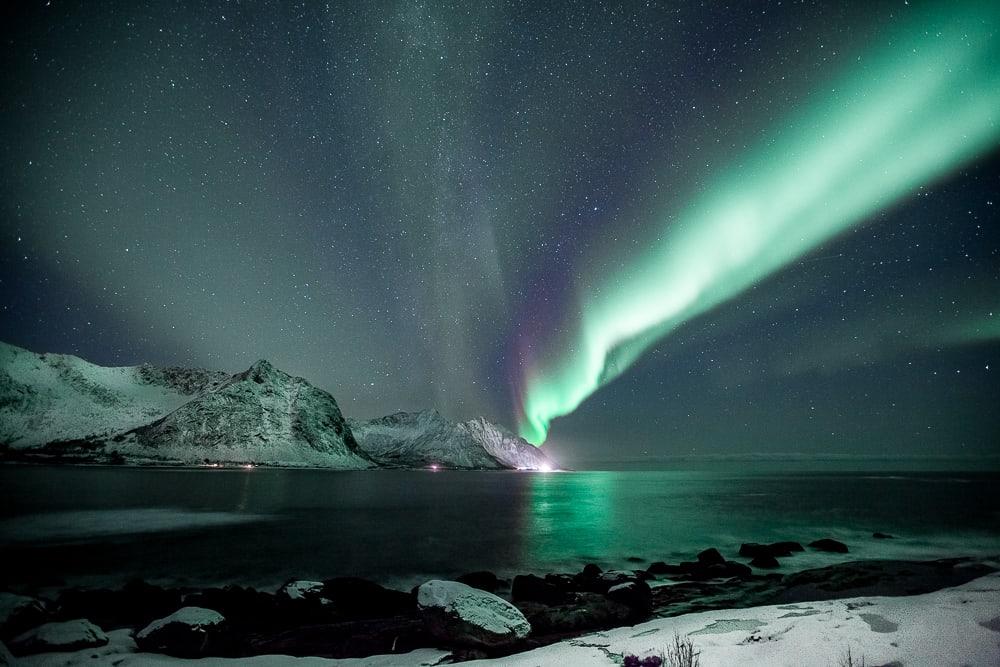
Northern lights photography setting: ISO 1600, f/2.8, 10 second exposure
Aperture
You’re shooting in the dark, so you’ll want your aperture to be as wide as possible (the lowest f number), to let in as much light as possible.
Right now I shoot the aurora with a Sony 20mm f/1.8 lens, so I will set the aperture to 1.8 (the widest it goes). But I used to shoot on a Canon 24-105mm f/4 lens, and I still got good shots with an aperture of 4.
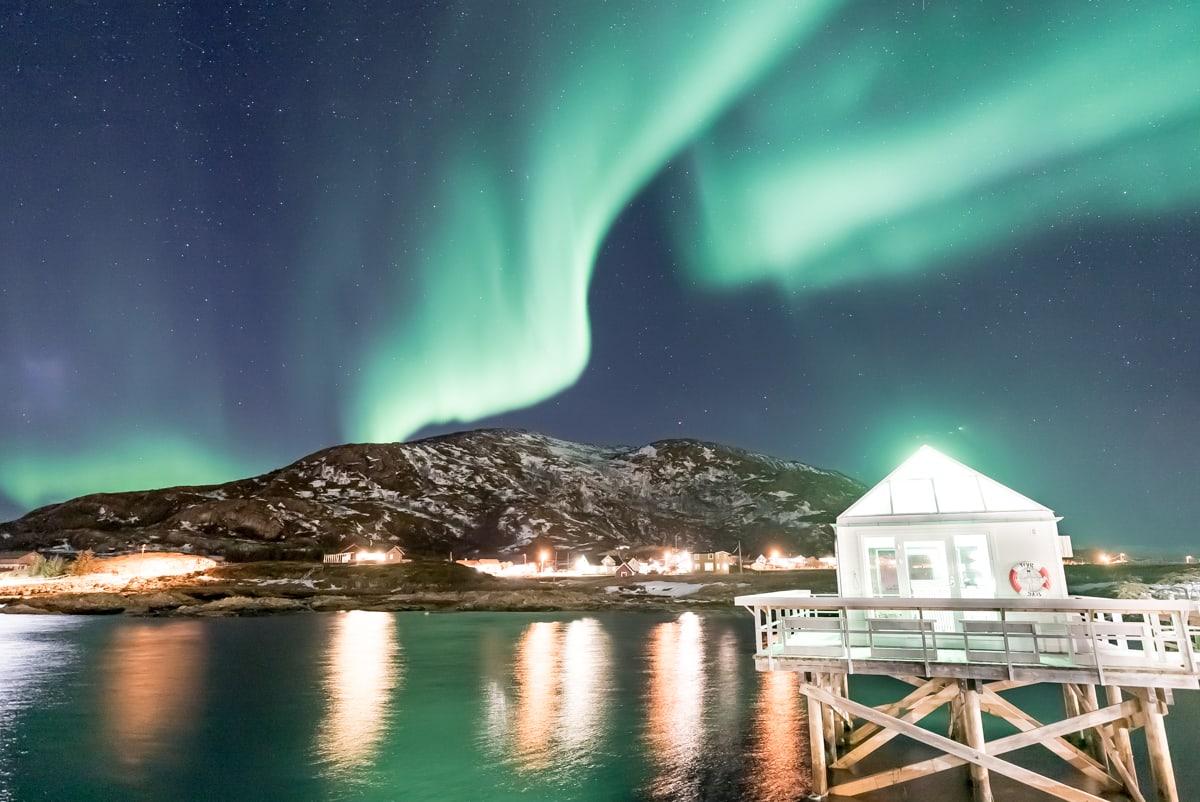
Northern lights camera setting: ISO 800, f/1.8, 3.2 second exposure
ISO
I usually set my ISO to 1600, unless it’s really dark and the lights aren’t that strong, in which case I might bump it up to 3200. I will also use 3200 if I want to capture more detail in the aurora, as then I can use a shorter shutter speed, which will result in less blur. A higher ISO makes for a more grainy photo though, so generally I prefer to stick around 1600.
Different cameras also have different lowlight abilities, so while an ISO of 3200 looks okay with my camera (Sony A 7s III), it might look more grainy on others, or less grainy, depending on the camera. It would be worth testing some night shots on your camera so that you get an understanding of how the different ISO levels will look.
Since the ISO and aperture settings are usually the same regardless of the conditions, I set these beforehand so I don’t have to fumble too much in the cold and dark.
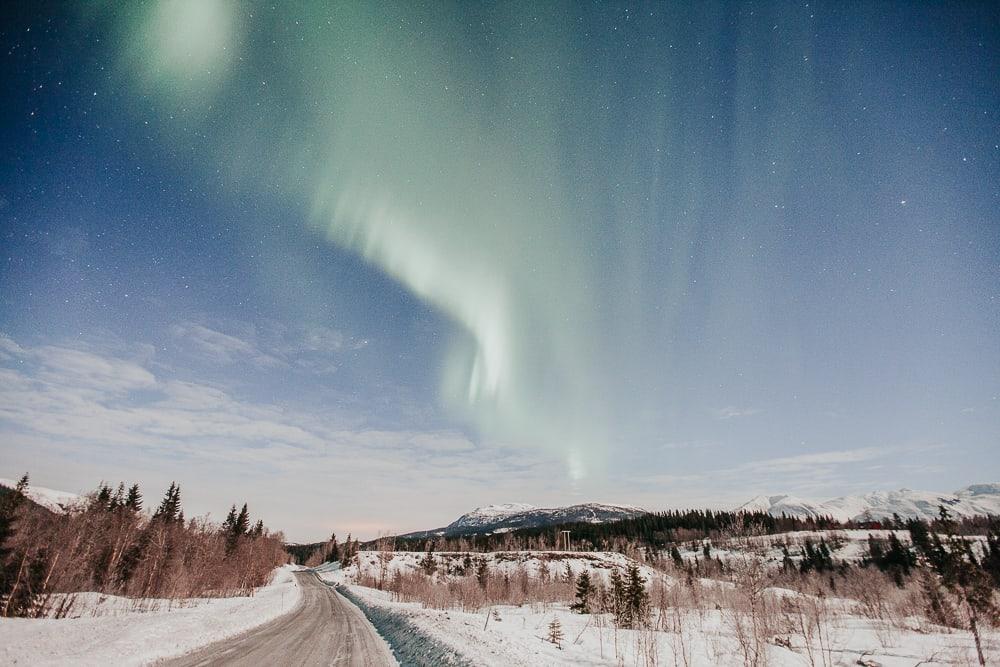
Northern lights photo setting: ISO 1600, f/2.8, 4 second exposure
When you’re outside (you’ll probably want to use a headlamp for this part):
Focus
Switch your camera to manual focus. You’ll need to lock your camera to focus to “infinity,” the farthest distance it can focus to. The infinity point is usually marked on the lens, though be aware that the marker isn’t always totally accurate – it’s a bit off on my camera.
Some people will find infinity focus during the daytime and then tape their lens in place or mark the true infinity focus point on the lens with tape or a marker. But I manually find infinity focus each time I go to shoot the northern lights, just so I can be sure it’s right.
To do this I find some distant lights to point my camera at, and then I turn on live view and zoom my screen (not the lens) in on the lights. Then I manually adjust my lens so that it focuses on the lights. It’s focused when the dots become as small as possible.
And yes, I always keep my focus at infinity, even if I want an object in the foreground, as I want the aurora and stars to be in sharp focus.
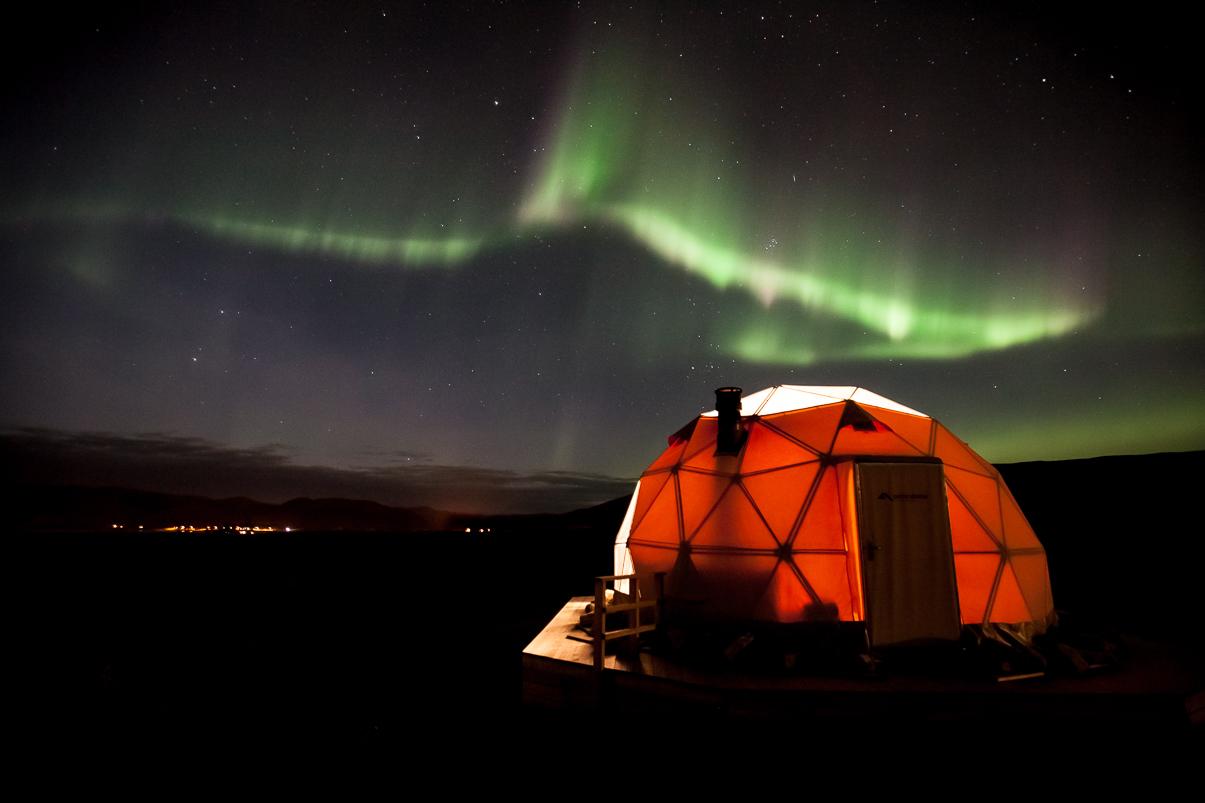
Northern lights photo setting: ISO 3200, f/2.8, 2.5 second exposure
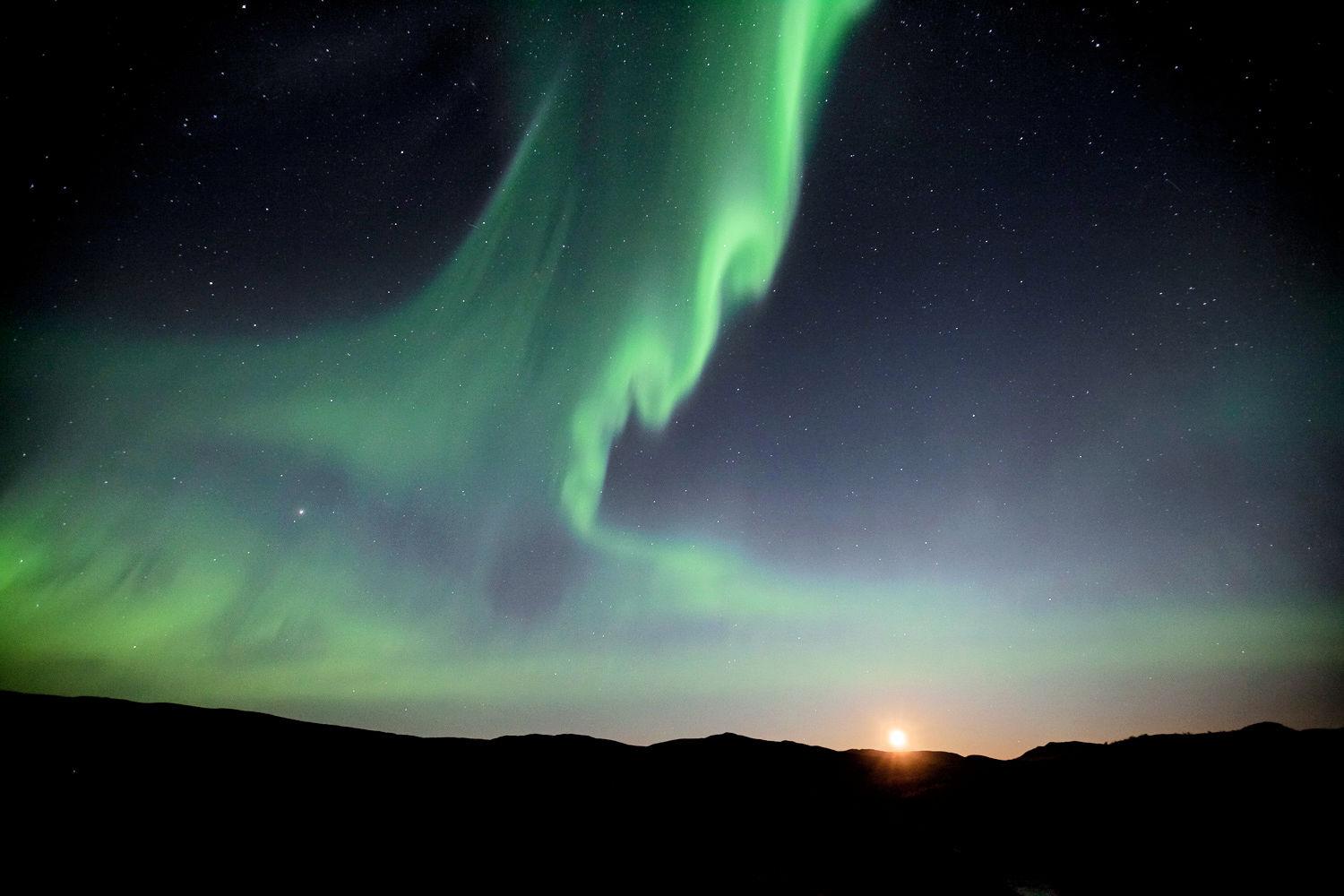
Photo setting: ISO 1600, f/2.8, 4 second exposure
Shutter speed
Usually shutter speed is the only setting I really change depending on the conditions.
Here a higher number means the shutter will be open for longer, which lets in more light, but also can cause motion blur and a loss of detail. Some motion blur is usually fine with northern lights photos, but if the lights are moving really quickly you’ll need a shorter shutter speed to capture more detail. Usually when they’re moving quickly they’re also really bright, so you don’t need to let as much light in anyway.
If I can see the northern lights but they aren’t moving quickly, I’ll usually start with a shutter speed of around 10 seconds. If the photo doesn’t turn out bright enough I’ll bump it up to around 15 seconds, and if it’s too bright/the aurora is too blurry I’ll bump it down.
Remember, you can brighten your photo by choosing a wider aperture, a longer shutter speed, or a higher ISO. Assuming your aperture is already set to its widest, if your photo is too dark but you’re also getting too much motion blur, you can lower the shutter speed and choose a higher ISO instead.
And even if you can’t see the aurora at all, your camera might still be able to capture it! You can try to bump your ISO up to 3200 and your shutter speed to 20 or even 30 seconds and point your camera north at the sky and see if you capture some green light.

Northern lights photo setting: ISO 1600, f/2.8, 13 second exposure
Place your camera
Once you’ve figured out your settings, you’ll want to set your camera up on its tripod. If your camera has an image stabilization mode, turn it off, as it doesn’t work with tripods and can actually cause shakiness when on a tripod.
Then plug in your intervalometer or remote, if you’re using one. If you’re not you might want to turn on your camera’s self timer to the shortest setting (eg. 2 seconds) so that the camera fires a couple of seconds after you hit the shutter button. This will eliminate any shakes that could result in blurry photos.
Now frame your photo. If the aurora hasn’t appeared yet, this is a good time to perfectly frame your shot so you’ll be ready to start photographing as soon as the aurora appears. You’re going to get so frantic and excited when the northern lights appear that it will probably be hard to think, so planning as much as possible in advance really helps!
I’ll usually point my camera north and then decide on a pretty shot, maybe including any mountains or lakes in the foreground. Of course I might change this later depending on where in the sky the aurora appears, but it’s good to have a nice shot or two in mind so you don’t have to stress over framing when the lights are active.
Now turn off your head lamp and wait for the aurora to appear!
If it’s really cold (below -20C), don’t keep your camera set on your tripod when you’re not using it, as the circuits could get damaged. Instead keep it warm until you’re ready to use it.
My top tip here would be to practice all of this ahead of time and set up as much in advance as possible. It can be hard to focus on camera settings when the northern lights are exploding above you, and as some northern lights displays only last a minute or two, you’ll need to move quickly. Being familiar with all the settings will be a great help in the moment.
And the next day, remember to put your ISO back on auto, as well as to switch back on stabilization mode and autofocus. You don’t want to accidentally take daytime photos with a really high ISO, as they’ll turn out grainy.

Photo setting: ISO 3200, f/2.8, 2 second exposure
Getting a selfie with the northern Lights
If you want to get in your northern lights photos you have two options.
If you’re own your own, you can keep all the settings the same as I described above, and simply get in the photo. This will work better if you keep a bit of a distance from your camera, as your focus will be set to infinity, so your camera is going to focus on objects far away.
Then you’ll have to stay as still as you possibly can for the entire time the shutter is open (so if your shutter speed is set to ten seconds, you’ll need to keep still for the full ten seconds). Any movement will cause your image to be blurred in the photo.
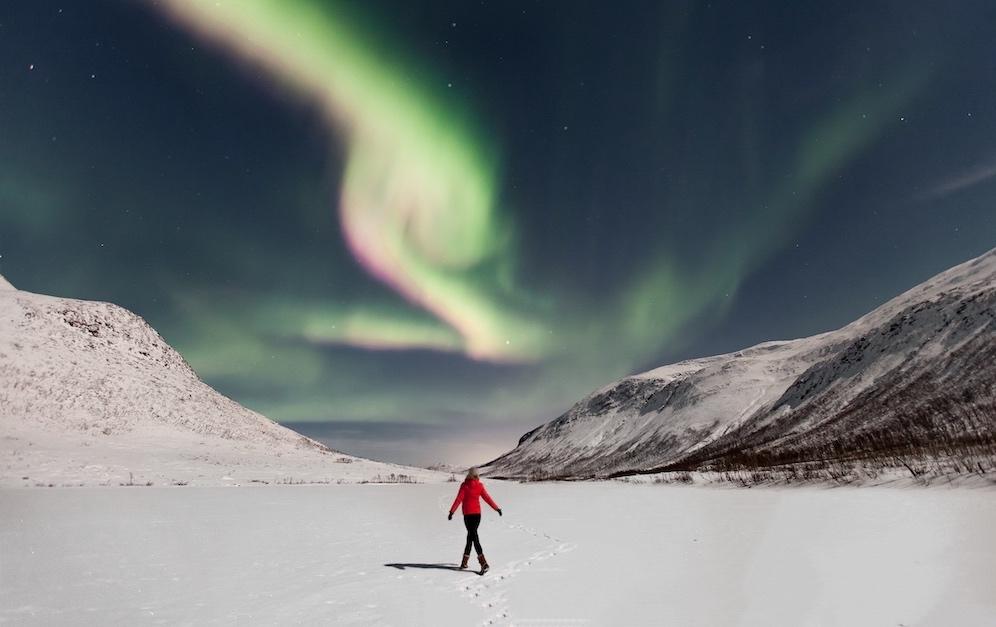
Northern lights photo setting: ISO 1600, f/2.8, 3.2 second exposure
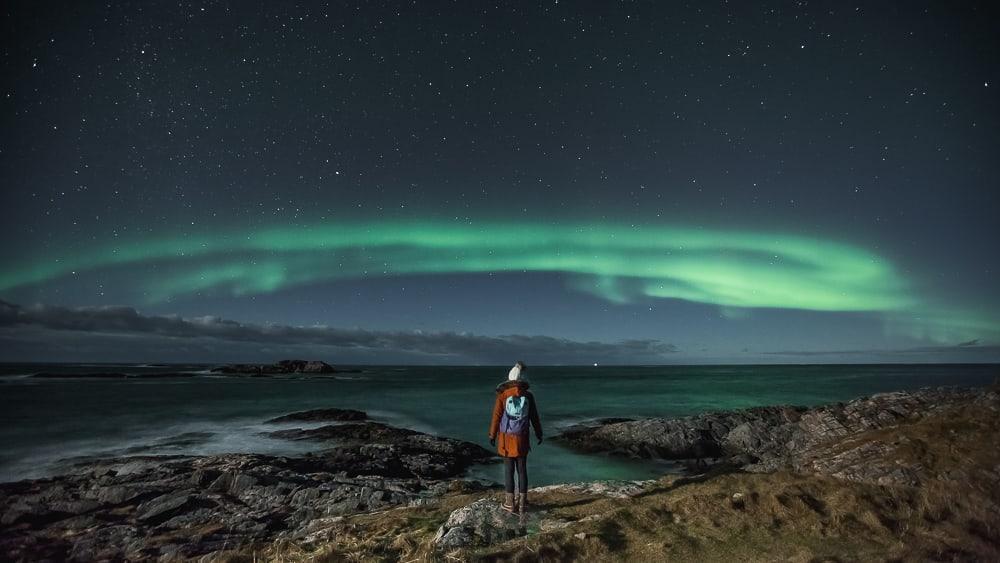
Northern lights photography setting: ISO 1600, f/2.8, 10 second exposure
If you want to illuminate your face, ask a friend to help you.
First, have them shine the light on you and reset the camera focus to your face. You can do this either manually, or you could try to put your camera back on autofocus so it focuses to your face, and then immediately switch it back to manual focus so the focus doesn’t move again.
Then after they push the shutter button on the camera to take the photo, have them shine the light on your face – but only for a moment! A split second is enough for the camera to capture your lit face without messing up the lighting of the rest of the photo.
Filming the northern Lights
If the northern lights are incredibly bright, you might be able to catch them on video mode on your phone or camera. But if you’ve taken videos at night you know that they turn out super grainy.
An exception is if you have a camera with incredibly high ISO options. I recently bought the Sony A 7S III for exactly this purpose, and it does take incredible videos of the northern lights. But most other cameras don’t have as good low light capabilities in video.
If you want cleaner video footage that looks as good as your photos, well, use photos!
Before getting my new camera, instead of trying to film the northern lights, I would always take sets of photos that I could later stitch together into a time lapse.
Some cameras have a time lapse mode, but mine doesn’t so I use an intervalometer. With an intervalometer you can set your camera to take a photo every few seconds (eg. one photo every 5 seconds). Alternately, if your camera connects to your phone you can use a camera app like Camrote to set up a time lapse.
Because of the long exposures needed to capture the northern lights, I usually just put my camera on burst mode and lock the shutter down with the intervalometer so that the camera continues to take photos one after the other.
The only downside to this is that you need a lot of photos for a good time lapse – like usually at least a hundred – which means that your camera will be locked in one place during the northern lights display.
This is fine if there’s only really one viewpoint you want to capture, but if you want to get a few different perspectives, waiting to capture enough photos for your time lapse can be annoying (especially if the lights display doesn’t last long). So it’s worth thinking about whether you’d prefer to get a bunch of different photos or one nice time lapse.
Once you have the photos you can import them into your video editing software (I use FinalCut Pro X, but your computer’s free video editing software like iMovie should work fine).
Ideally you should set each photo’s duration to one frame, which means that for a 10 second video clip showing 25 frames a second, you’ll need 250 photos. However if I don’t have enough photos or want a longer clip I’ll sometimes fudge it and set each photo to be three frames and it still looks fine.
YouTube has tons of tutorials for how to create time lapses from still photos, so if you’re confused I’d recommend checking there for a tutorial for the video editing software you’re using.
Caring for your camera gear in the cold
Freezing temperatures aren’t just uncomfortable for you, they also affect your camera equipment.
First of all, batteries do not like cold temperatures, so you’ll want to bring at least one spare battery (more if you plan to be out a really long time). This goes for your phone as well – you’ll definitely want a full power bank to plug into. Keep them in a pocket close to your body so they stay warm, otherwise they will lose power.
Personally I’ve never bothered with this, but if you’ll be shooting in extremely cold temperatures (think, below -20C), you might consider wrapping a hand warmer around your lens. You can simply use a hairband to fasten a hand warmer on the underside of the lens (heat rises), or I’ve seen people cut off the toe of a sock and use the remainder of the sock to keep the warmer in place, sort of like a scarf for your lens.
Be careful not to breathe in front of your lens when making adjustments, as the condensation could freeze.
And when frozen, plastic breaks really easily, so you’ll want to be particularly careful with your tripod in the cold if it has any plastic parts.
When you aren’t using your camera, make sure to keep it in its bag. Keeping your camera out in extreme cold when it isn’t turned on can damage the internal elements.
And then when it’s time to head back into the warmth, you’ll want to keep your camera in its camera bag for at least half an hour after you bring it inside. Ideally put it in an airtight bag in a cold area of your home. This will let the camera warm up as slowly as possible, which will help to avoid any condensation that could potentially damage your camera. You don’t want to open the bag until the camera is at room temperature, which may take a couple of hours if it was really cold.
I know, whenever I come inside all I want to do is check out my aurora photos, so the wait can be agony! But I imagine the agony of ruining my camera would be worse, so it’s worth the wait.

northern lights photo setting: ISO 3200, f/2.8, 4 second exposure
And that’s about it! I know it sounds like a lot, but it’s really not that complicated once you do it a few times, and seeing the results is so much fun that your northern lights trip might just turn you into a hobby photographer.
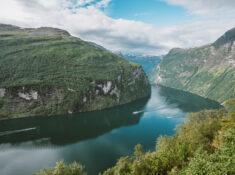
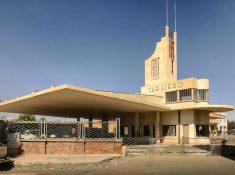
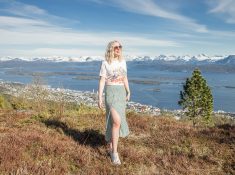
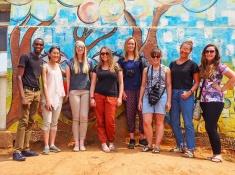
Nynke says
Wow, so many tips that ooze experience! I wouldn’t even know to think about some of these (like, slowly warming up your camera?)… And it’s all wonderfully clear too, and helps me fantasize about one day doing this. There’s just one phrase that I don’t get: “lock the shutter down with the intervalometer”. What does that mean? What does this the intervalometer do, exactly?
Silvia says
The intervalometer can fire the camera for you, so you don’t have to press down on the shutter button to take a photo. The intervalometer also gives you the option to lock down the shutter button, which does the same thing as if you were continuously holding down the shutter yourself (the button you click to take a photo), so it continues to take photos. Haha hard to explain in writing I guess!
Nynke says
Ahaaa… Now I get it, thanks!
Zubida Khatoon says
That’s a great post for learning so many things to photograph northern lights. I think basic adjustments like contrast, brightness, and tone can make a world of difference and most cameras offer these editing features in the device.
ASHEBD says
Thanks for sharing.
Džangir says
Nice post with lots of useful info
Tomasz says
What od your opinion on using exposure correction when photographing or filming aurora? My camera allows minus 5 till plus 5.
Silvia says
I never use it, but I shoot in raw so I can adjust in post.
Alpha Masking says
This is a really cool blog post about photographing northern lights and how to go about it. I like how you explain some basics of photography and how to capture the northern lights with a photo. It was also really helpful to learn about the northern lights hotels in Norway. I’ve always wanted to go to Norway but never had the chance so I’m glad you shared that info!
Zabid says
Nice collection by the way.. loved it. this is very usefull. Thank you
556 gun says
Cool photos! What exposure did you use?
Silvia says
The exact camera settings are written directly under the photos.